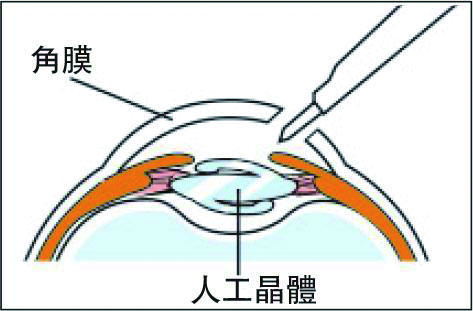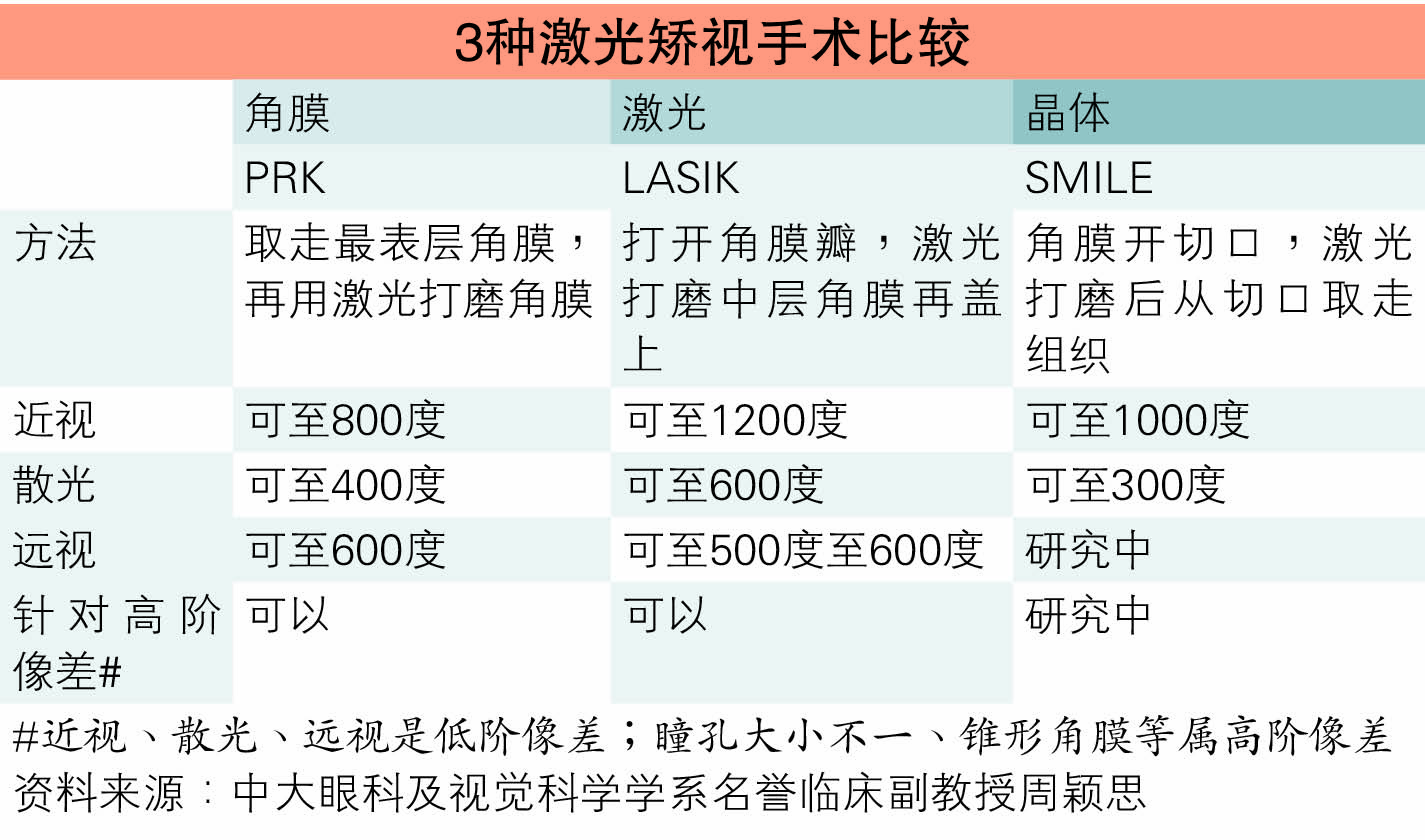Considering the doctor’s skills and the patient’s condition, choose the corrective surgery according to the needs
[ad_1]
Text: Zheng Baohua, “Ming Pao”
Vision correction surgery has been developed for decades, and laser vision correction has entered the third generation, from the first generation of PRK, the second generation of LASIK to the third generation of SMILE. Not only are the wounds smaller, but the recovery time is also shortening; Implantable contact lenses on the market, as well as replacement “trifocal” and “extended depth of field” intraocular lenses, are suitable for the treatment of cataracts in the early and the elderly and the correction of myopia, hyperopia, astigmatism, and presbyopia.
The choice is overwhelming.
(Hong Kong News) Many four-eyed people are thinking about correcting their vision and releasing the shackles of glasses, but they are worried about potential safety hazards. When choosing these non-essential surgeries, is the newer the safer? What are the risks to consider?
Each surgery has its advantages and limitations
Which vision correction surgery is best? The “good” in everyone’s mind includes safety, high standards, and few sequelae.
Zhou Yingsi, Honorary Clinical Associate Professor of the Department of Ophthalmology and Visual Sciences of CUHK, pointed out that laser vision correction surgery is highly safe. Whether it is PRK in the 1980s, LASIK in the 1990s, or SMILE that appeared in 2008, all of them have been approved by the FDA, and there are a large number of them. Research proves it works.
However, each procedure is unique and has different advantages and limitations.
First Generation: Laser Vision Surgery (PRK)
The cornea is more stable when the wound is large and painful
◆Began to implement in 1987, approved by FDA in 1995
◆There are 5 layers of the cornea, the most superficial layer is removed first, and then the cornea is directly polished with laser to change the curvature of the cornea
◆The wound is relatively large, the recovery time is about 1 to 2 weeks, and there will be pain
◆The advantage is that there is no corneal flap, the cornea will not be too thin after the operation, and it is relatively stable
Second Generation: Laser Vision Surgery with Corneal Incision (LASIK)
1 to 2 days recovery standard is constantly improving
◆Began to implement in 1991, approved by FDA in 1996
◆Cut a thin flap on the cornea, then open the corneal flap, polish the middle layer of the cornea with an excimer laser, change the curvature of the cornea, and finally cover the corneal flap
◆The wound is covered by the corneal flap, the wound on the surface of the cornea is just a circle, the pain is greatly reduced, and the recovery time is about 1 to 2 days
◆The application time is the longest, and the accuracy of vision correction is continuously improved
Third Generation: Small Incision Lens Excision (SMILE)
The wound is small and the hyperopia cannot be corrected
◆Implemented in 2008, approved by FDA in 2016
◆No need to fully open the corneal flap, only cut a 3 mm incision around the circumference, use laser to remove the middle layer of the cornea, change the curvature of the cornea, and take out the resected tissue through the small incision
◆The advantage is that there is no corneal flap, and the cornea is relatively stable; it does not damage the nerve line, and the problem of dry eyes is less
◆The wound is only 3 mm, and the recovery time is about 1 to 3 days
◆Because the technology is relatively new, the degree of correctable vision is still under study, and hyperopia cannot be corrected temporarily, and other effects are to be confirmed by more clinical studies
SMILE has a smaller wound and is safer
Zhou Yingsi compared the three types of laser vision correction surgery, and pointed out that both PRK and LASIK may cause eye dryness, but generally after about 6 months, the problem will improve after the nerve line regenerates. LASIK has the longest clinical application time, has a large amount of data, and is very accurate in calculating the degree of cutting.
SMILE has no corneal flap, less dry eyes, and minimal wounds, which is theoretically safer.
As for PRK, although it is not mainstream, it has not yet been eliminated. If the patient’s cornea is too thin to do LASIK, or needs minor correction after undergoing other vision correction surgery, PRK may be considered.
She emphasized that there is currently no research to prove which laser is superior, so the choice depends on different considerations such as the doctor’s skills and the patient’s condition.
If the diopters are too high or the cornea is too thin for laser vision surgery, implant vision surgery may be considered.
Surgery can be divided into two categories. Zhou Yingsi pointed out that one is the implantable crystal mirror (Phakic IOL), and the other is the replacement of the intraocular lens (IOL).
Myopia 2000 degrees can do IOL
Implantable Lens (Phakic IOL)
Can save myopia test doctor’s skills
Implantable lenses, also known as implantable contact lenses, are lenses that are placed in front of the lens. Zhou Yingsi pointed out that its advantage is that it can correct deep refractive errors. Myopia can reach 2000 degrees, astigmatism 400 degrees, and hyperopia 1000 degrees. In recent years, extended depth of focus (EDOF) lenses for presbyopia have begun to appear.
“Implantable lens mirrors pay attention to the doctor’s skills; and they are always invasive operations. In case of bacterial infection, the bacteria can cause blindness and cause great harm; while laser vision correction surgery, in case of bacterial infection, the bacteria only enter the cornea. Superficially, worst-case cornea transplantation and vision preservation.”
She emphasized that the risk of bacterial infection or other complications is minimal, and some studies have shown that the vision correction effect of implantable lenses is better than that of laser vision correction.
Replacement intraocular lens (IOL)
For any degree of farsightedness and presbyopia
If myopia exceeds 2000 degrees, you may want to consider replacement intraocular lens (IOL) surgery, which can be used for myopia, hyperopia and presbyopia of any degree.




Trifocal IOL Realize seeing far, middle and near clearly
To deal with presbyopia, PRK, LASIK, and SMILE all achieve monovision (monovision), that is, one eye corrects all degrees to see distant objects, and the other eye retains a small amount of myopia to see near objects; however, monovision will affect stereoscopic vision. Vision will also affect night driving vision, which may not be accepted by everyone.
In addition, some people try to use LASIK to cut different thicknesses in different positions of the cornea to achieve bifocals and trifocals, and can see far, middle and near objects at the same time, but the effect is not satisfactory.
Replace artificial lens to deal with presbyopia
People want to correct myopia in middle age, but at the same time they start to have presbyopia and even mild cataracts. Zhou Yingsi suggested to consider replacement of intraocular lens, “equal to early cataract surgery”, remove the original lens, and replace the intraocular lens.
“In recent years, for presbyopia, there are a variety of artificial lens options,
Including bifocal (bifocal), trifocal (trifocal),
Extended depth of focus (EDOF) is relatively mature.
Before considering corrective surgery, whether it is laser or implant, it will indeed make life easier, but it is not a necessary operation.
In addition, surgery cannot change other problems caused by myopia, such as glaucoma and the risk of retinal detachment, so don’t have unrealistic expectations. “
She explained that currently the most commonly used is the trifocal and extended depth of field intraocular lens. The trifocal IOL can clearly see the near, middle and far distances, and the positions beyond the 3 points may be a little blurry. The extended depth-of-field intraocular lens can see near-medium or mid-to-long distances, and the patient’s two eyes are respectively placed to see the near-medium and mid-to-long distance IOLs, which can achieve a modified mini-monovision effect, which is coordinated by the brain For the eyesight of both eyes, “you can see the whole process, but it may be a little ‘blurred'” in the whole process. The actual effect needs to be experienced by the patient.
High risk of glaucoma should not be corrected
“On the contrary, if you wear contact lenses for a long time, but your personal hygiene is poor, you don’t need to wear contact lenses after optoscopic surgery to reduce the risk of bacterial infection.”
She pointed out that vision correction surgery has been done for quite a long time and has a high degree of safety. However, everyone’s eyes are different, so you should discuss the risks of surgery with your doctor. If the cornea is not thick enough, laser vision correction is not suitable, or you need to consider implanting lens lenses ; And those with a higher risk of glaucoma may not be suitable for corrective surgery.
[ad_2]
Source link

![[Love Wants Sexual Happiness Series 358]Find the culprit and overcome psychogenic erectile dysfunction. Don’t let pressure affect your sexual happiness.](https://chinathenews.com/wp-content/uploads/2024/04/171111-780x420.jpg)

![[Wanqingyi Care]My health, my rights, customized medical methods in the last stage of life](https://chinathenews.com/wp-content/uploads/2024/04/ZZ1-100-780x420.jpg)
![[Kidney Transplantation Special Topic]The survival rate of transplanted kidneys is high without dialysis treatment three times a week](https://chinathenews.com/wp-content/uploads/2024/04/1311-780x420.jpg)



